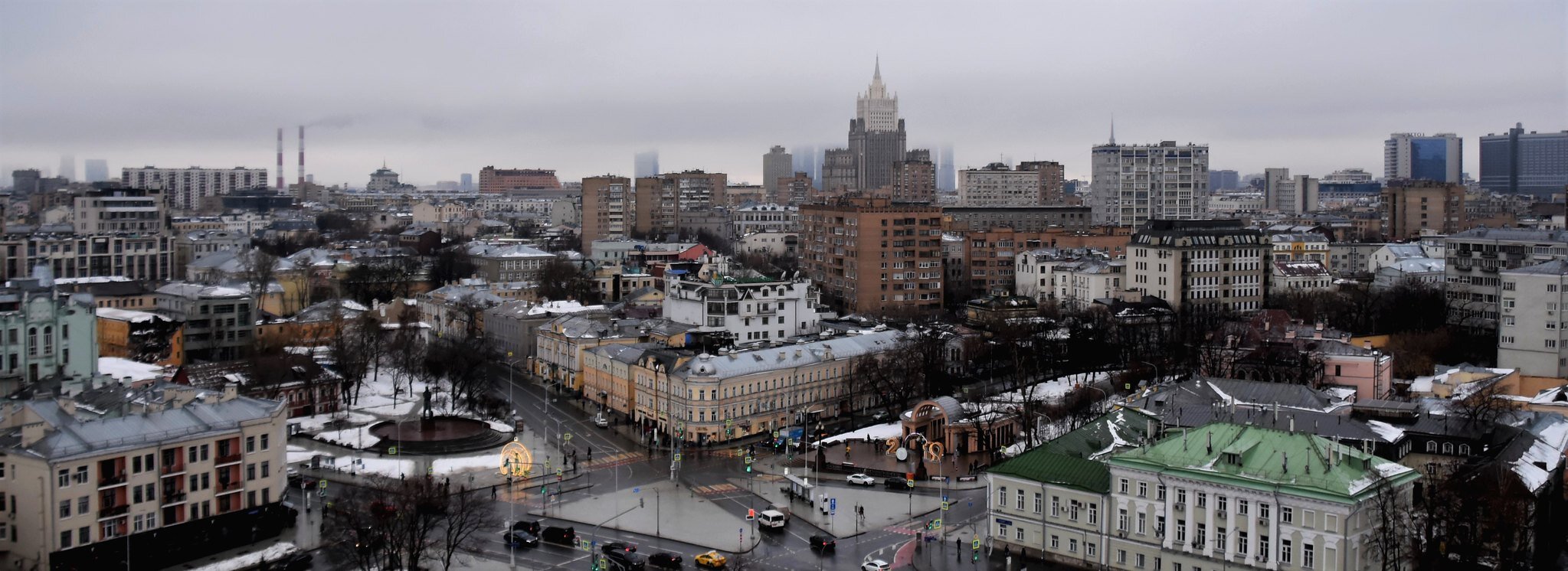Saint Basil’s Cathedral, Moscow.
*Note: This post is based on notes from my visit to Moscow in 2019, where I was lecturing on narrative design in gaming.
There are Christmas lights everywhere.
They sprawl across the city, radiant canopies slung over streets and alleys — low rooftops made from twinkling lamps and fairy-lights, brightening up the thoroughfares. The famous GUM department store is covered in sparkling strings of them; there’s an army of brilliantly-embellished Christmas trees arranged in formation opposite Red Square, glittering at attention.
The square itself is dominated (between ruddy walls and beneath the shadow of Saint Basil’s Cathedral) by a half-disassembled stage. The remnants of a festive show, being taken apart by busy workers.
It is the start of March.
Across the city, “2019” regularly sprouts from the pavement in giant glowing numerals. Leftover decorations from the new year, still hopelessly committed to the party.
The streets are covered in ice. The ground is slippery, the wind pushy and biting. Walking the promenades of central Moscow, taking in the obligatory sights (the Kremlin, the Cathedral of Christ the Saviour, the Soviet Arcade Museum) — it’s a challenge to stay balanced. During the day industrious sweepers in orange jackets brush away the snow as best they can. But I’m out exploring after dusk, and snowflakes are falling in fresh waves, covering the undefended streets anew.
Moscow in snowfall. Just like in the movies.
*
At one point, I wander into an art exhibit. It’s a small back room in the Soviet Arcade Museum, home to a modest crowd watching a screen. They’re regarding footage of Moscow at the turn of the twentieth century, rendered in flickering black and white. The city is frozen, its river solid. The Kremlin looms over frigid banks, trafficked by horses, carriages and the occasional wooden sled zipping along. I watch the movie in silence, its commentary inscrutable, before slipping quietly out.
Back on cold streets, my stomach rumbles. A fancy restaurant offers some reprieve; a steaming plate of purple Borscht.* The price is surprisingly reasonable.
I ask some people (here and there) why Christmas lights are still up in March. They tell me they simply haven’t been cleared away yet. They brighten up the place. One local grumbles about the electricity bill, fearing it must be getting vast.
It certainly makes an impression.
*
One of the Seven Sisters, the Moscow skyline, a subway station, lights, and Christmas celebrations outside Red Square (with bagpipes and masks).
The metro stations in Moscow are notoriously striking — built under Stalin’s dictatorial regime, they were designed to be Palaces of the People, furnished with statues, murals and mosaics that would put any art gallery to shame. The city is home to buildings called the Seven Sisters — huge, art deco concrete high-rises, built in the 1940s/50s as a stab at capitalist skyscrapers in the West. The city’s outer reaches are thick with enormous Soviet-era tenement blocks — looming, monolithic superstructures, clustered like colluding giants.
In other words, it’s a city that suits displays of grandeur.
I’m only here for a few days. I have time to glimpse the streets, covered in snow — grandeur of the natural sort, a blanket dropping far and wide.
There’s so much history here I can almost taste: riot and revolution, transition and tribulation, capitalism, communism, war and peace and strife and a black cat prowling the streets, sent to wreak havoc by the devil. Too much to sample, in a short time.
The snow will melt, eventually.
I will not see what’s underneath.
This post was inspired by the fact that Moscow is currently experiencing a historically warm winter – prompting (in a rather ostentatious display) the government to provide the city with a new year coating of artificial snow.
*Deriving from an ancient Hogweed soup, Borscht is a traditional Slavic dish with strong cultural associations in several countries across Eastern Europe. It comes in many variations, and is most widely known for its Ukrainian beetroot form.
I’m not sure which version I had, but it was mostly cabbage. Delicious cabbage.















